The original St. Michael Catholic Church was the center of the third oldest parish in San Antonio, Texas, and a nucleus for the Polish people of the city. It began with the arrival of Father Vincent Barzynski of the Resurrectionist Order who was the earliest resident pastor. On November 18, 1866, the first Mass of the newly organized parish was celebrated in the San Fernando Cathedral. St. Michael’s divine services were initially held in a rented one-story, rock building owned by Emanuel Rzeppa [photos below].
In 1867, Rev. Barzynski wrote to Father General Kajsiewicz from San Antonio: “It is true that the population of my parish amounts to some 44 to 50 families…the total number of people under my protection…comes to about 250…” (Kruszka, page 324). The first church was constructed in 1868, and five years later, St. Michael’s School was opened.
Following Father Vincent Barzynski as pastor were: Rev. Joseph Barzynski, Rev. Stanislaus Wojciechowski, Rev. Felix Zwiardowski, Rev. Adelbert Pelizar, Rev. Ludwig (Louis) Dombrowski, and Rt. Rev. Thomas Moczygemba.
In 1922, the original church was torn down and a larger edifice of white brick was erected. The cornerstone of this majestic church was laid on July 4, 1922, followed by the dedication on October 25, 1922. The blessing of the beautiful stained glass windows took place on December 2, 1923.
This historic church, with St. Michael the Archangel as its standard bearer, was demolished to make room for the 1968 HemisFair.
Sources:
Gilbert, Rev. M.J., compiler and editor. Archdiocese of San Antonio, 1874-1949: An illustrated record of the foundation and growth of parishes, missions, and religious institutions in that part of Texas under the spiritual jurisdiction of the See of San Antonio. San Antonio, Texas: Schneider Printing Company, 1949.
Kruszka, Wacław. A History of the Poles in America to 1908. Washington D.C.: The Catholic University of America Press, 1998.
St. Michael’s Catholic Church 1866-1966 Centennial. San Antonio, Texas: Privately printed, 1966.
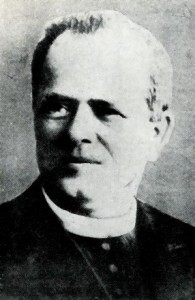 Rev. Vincent Barzynski, the first resident pastor of St. Michael’s parish, was known as a humble and hard-working priest. His superior in Texas, Rev. Adolf Bakanowski, described him in the following manner in 1870: “Father Wincenty suffers from lung disease; he is under the care of Doctor Herff in San Antonio. Illness could always have been expected because he was working as hard as an ox without break from morning until 11 p.m. This was not necessary, but he usually devised a thousand different activities for himself and wanted to satisfy everything most carefully…he is a fervent priest…” Yet Rev. Barzynski explained, “I am not working like an ox but like a mother at the wedding of her only daughter…” thus expressing his sincere devotion to his parishioners (Kruszka, page 325). Rev. Barzynski remained pastor of St. Michael’s from 1866-1873.
Rev. Vincent Barzynski, the first resident pastor of St. Michael’s parish, was known as a humble and hard-working priest. His superior in Texas, Rev. Adolf Bakanowski, described him in the following manner in 1870: “Father Wincenty suffers from lung disease; he is under the care of Doctor Herff in San Antonio. Illness could always have been expected because he was working as hard as an ox without break from morning until 11 p.m. This was not necessary, but he usually devised a thousand different activities for himself and wanted to satisfy everything most carefully…he is a fervent priest…” Yet Rev. Barzynski explained, “I am not working like an ox but like a mother at the wedding of her only daughter…” thus expressing his sincere devotion to his parishioners (Kruszka, page 325). Rev. Barzynski remained pastor of St. Michael’s from 1866-1873.
 Emanuel Rzeppa (1829-1899) and his first wife, Matilde Heinrich, were charter members of St. Michael Catholic Church. After immigrating from Toszek, Silesia, they acquired property on the corner of Matagorda and Goliad Streets where they lived and operated their bakery. On November 26, 1867, Emanuel posted his first ad in the San Antonio Express for sale of the property. The ad noted that “…the house has 3 rooms, each 20×18 feet; a warehouse is attached 40 x 16 feet. All in good order and title guaranteed” (page 2). It was not until July 24, 1868, that Emanuel sold the property to his brother-in-law, Carl August Richter, and his wife, Julia Rzeppa, after the warehouse was used as a temporary church (Bexar County Deed Records, Book U, No. 1, page 495). [Photograph courtesy of Lynn Highley]
Emanuel Rzeppa (1829-1899) and his first wife, Matilde Heinrich, were charter members of St. Michael Catholic Church. After immigrating from Toszek, Silesia, they acquired property on the corner of Matagorda and Goliad Streets where they lived and operated their bakery. On November 26, 1867, Emanuel posted his first ad in the San Antonio Express for sale of the property. The ad noted that “…the house has 3 rooms, each 20×18 feet; a warehouse is attached 40 x 16 feet. All in good order and title guaranteed” (page 2). It was not until July 24, 1868, that Emanuel sold the property to his brother-in-law, Carl August Richter, and his wife, Julia Rzeppa, after the warehouse was used as a temporary church (Bexar County Deed Records, Book U, No. 1, page 495). [Photograph courtesy of Lynn Highley]
 In December of 1866, Father Vincent Barzynski rented Emanuel Rzeppa’s stone building on the northeast corner of Matagorda and Goliad Streets. Recalling the beautifully appointed churches in their Silesian motherland, the congregation created a temporary chapel reflecting their piety in the warehouse: “The walls were scrubbed until they were immaculate and several of the men who were carpenters built benches and an altar. A big patch of cloth was then spread over the ceiling in arch form and this was painted blue to represent the sky and little glit[tering] stars were pasted on this ceiling as a background. Among the number of immigrants there was one who was an artist and this one painted several angels on the ceiling. And also among their number was an expert hand carver who carved out figures of angels and saints” (San Antonio Light, October 11, 1914, page 4).
In December of 1866, Father Vincent Barzynski rented Emanuel Rzeppa’s stone building on the northeast corner of Matagorda and Goliad Streets. Recalling the beautifully appointed churches in their Silesian motherland, the congregation created a temporary chapel reflecting their piety in the warehouse: “The walls were scrubbed until they were immaculate and several of the men who were carpenters built benches and an altar. A big patch of cloth was then spread over the ceiling in arch form and this was painted blue to represent the sky and little glit[tering] stars were pasted on this ceiling as a background. Among the number of immigrants there was one who was an artist and this one painted several angels on the ceiling. And also among their number was an expert hand carver who carved out figures of angels and saints” (San Antonio Light, October 11, 1914, page 4).
[Photograph from parish centennial book]
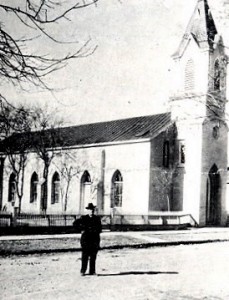 Father Barzynski acquired four lots on South Street as the building site. Then he wrote on September 25, 1867: “Today they began to cut out the weeds in the place where later today they will begin to dig the foundations for a building…to be 80 feet long and 27 feet wide. The church will be 50 feet in length, and the other 30 feet is for my home, the school, the sacristy, and the office. It will be made of soft stones, but the foundations will consist of hard ones…I cannot write more because I must go to measure the area for this house so that the digging can begin… Your suffering servant, begging for prayers and laying at the feet of the Most Reverend Fathers, Wincenty—Trusting in Victory.” On January 6, 1868, Rev. Bakanowski, as superior of the Polish missions in Texas, consecrated this first parochial building under the patronage of St. Michael in San Antonio (Kruska, page 324).
Father Barzynski acquired four lots on South Street as the building site. Then he wrote on September 25, 1867: “Today they began to cut out the weeds in the place where later today they will begin to dig the foundations for a building…to be 80 feet long and 27 feet wide. The church will be 50 feet in length, and the other 30 feet is for my home, the school, the sacristy, and the office. It will be made of soft stones, but the foundations will consist of hard ones…I cannot write more because I must go to measure the area for this house so that the digging can begin… Your suffering servant, begging for prayers and laying at the feet of the Most Reverend Fathers, Wincenty—Trusting in Victory.” On January 6, 1868, Rev. Bakanowski, as superior of the Polish missions in Texas, consecrated this first parochial building under the patronage of St. Michael in San Antonio (Kruska, page 324).
1922 – The construction of this church began on April 24, 1922. On July 4, 1922, Most Rev. Archbishop Shaw with twenty priests blessed the completed building. Rev. John Tokarz delivered a sermon in Polish. [Photograph and blueprints from parish archives]
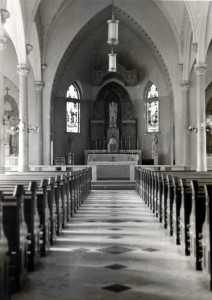 1922-1925 – The St. Michael’s parishioners donated many of the beautiful furnishings of their church including statues, golden tabernacle doors, marble altars and communion rails. The grand statue of St. Michael the Archangel towers over the main altar as the patron saint and protector of the parish.
1922-1925 – The St. Michael’s parishioners donated many of the beautiful furnishings of their church including statues, golden tabernacle doors, marble altars and communion rails. The grand statue of St. Michael the Archangel towers over the main altar as the patron saint and protector of the parish.
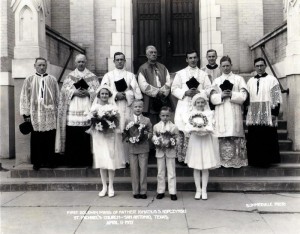 1937 – As pastor of St. Michael’s, Rt. Rev. Monsignor Thomas J. Moczygemba [center] appeared with the newly ordained Rev. Ignatius Kopczynski [5th from left], an alumnus of St. Michael’s Academy. Photo courtesy of: http://www.shorpy.com/node/6323
1937 – As pastor of St. Michael’s, Rt. Rev. Monsignor Thomas J. Moczygemba [center] appeared with the newly ordained Rev. Ignatius Kopczynski [5th from left], an alumnus of St. Michael’s Academy. Photo courtesy of: http://www.shorpy.com/node/6323
1950 – The above photo was taken at the celebration of Msgr. Thomas Moczygemba’s 60 years as a priest on January 5, 1950. From left to right are: Msgr. Anthony Drozd, Msgr. Patrick Geehan, celebrant, Rev. Julius Dworaczyk, Rev. Stanislaus Przyborowski, Msgr. Thomas Moczygemba, Rev. Theodore Janysek, and Rev. Erwin Juraschek, the Master of Ceremonies (with his back to the photographer). [Photo from the private collection of Most Rev. John W. Yanta, Bishop Emeritus, Diocese of Amarillo]

St. Michael Academy Christmas Pageant
1952- According to the archdiocesan newspaper, The Alamo Register, the St. Michael’s students in the above photograph are “…shown in the Nativity scene from their Christmas pageant, The Wondrous Story. Principal roles in the presentation were filled by Beverly Ann Riebe as the Blessed Virgin, Edmund Ebrom as St. Joseph, Patrick Brady, Frank Wesch, and Frank Laskowski as the shepherds; and Clifford Kosub, Arthur Leos, and Louis Yznaga as the Magi. The 18 small girls formed the angelic choir. (Photo by Avalos)” [Photograph courtesy of Christine Ebrom Cieslak]
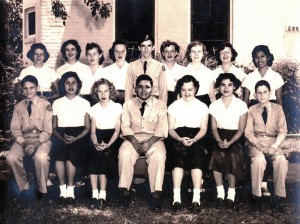 1953 – These eighth grade graduates of St. Michael Academy were:
1953 – These eighth grade graduates of St. Michael Academy were:
Back Row: Loretta Zaiontz, Marianne Blair, Patricia Edwards, Jo Ann Schultz, Edmund Ebrom, Ruth Ann Grams, Emily Pruski, Janice Tate, Irene Martinez
Front Row: Kenneth Sefcik, Nicky Maldonado, Nancy Mueller, Arthur Leos, Ethel Brady, Emma Garcia, Richard Yznaga [Photograph courtesy of Christine Ebrom Cieslak]
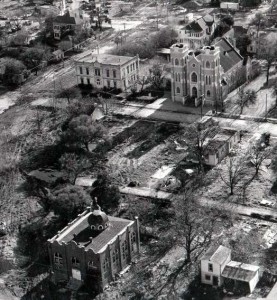 1966 – This is a pre-demolition photograph of the beautiful Gothic–style St. Michael Catholic Church facing South Street with St. Michael Academy on the left awaiting the wrecking ball and bulldozers. The domed building in the foreground is the original Rodfei-Sholom Synagogue on Wyoming Street. According to a featured article in the local newspaper, “A large segment of downtown and near-downtown San Antonio—the HemisFair site—has taken on the appearance of a bombed-out ruin. More than two years in advance of its April 6, 1968, opening, the 92-acre site is being rapidly cleared to make way for construction” (San Antonio Express and News, January 30, 1966, page 1-H). [Photograph courtesy of Lynn Highley]
1966 – This is a pre-demolition photograph of the beautiful Gothic–style St. Michael Catholic Church facing South Street with St. Michael Academy on the left awaiting the wrecking ball and bulldozers. The domed building in the foreground is the original Rodfei-Sholom Synagogue on Wyoming Street. According to a featured article in the local newspaper, “A large segment of downtown and near-downtown San Antonio—the HemisFair site—has taken on the appearance of a bombed-out ruin. More than two years in advance of its April 6, 1968, opening, the 92-acre site is being rapidly cleared to make way for construction” (San Antonio Express and News, January 30, 1966, page 1-H). [Photograph courtesy of Lynn Highley]
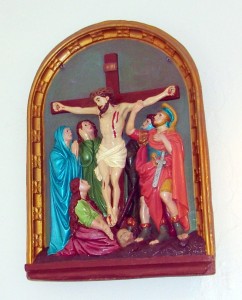 The 12th Station of the Cross – Jesus dies on the Cross. This particular station from the 1922 St. Michael Catholic Church was saved and is now a treasured artifact in the care of the Seraphic Sisters at 138 Beethoven Street in San Antonio, Texas. It is the only station whose location is known. In 1966, to commemorate the millennium of Christianity in Poland, Rev. Peter Kolton built a Shrine to Our Lady of Częstochowa, and it is most likely when the 12th Station from St. Michael’s was placed in the museum on the convent grounds. [Photograph by Elaine Mazurek Stephens]
The 12th Station of the Cross – Jesus dies on the Cross. This particular station from the 1922 St. Michael Catholic Church was saved and is now a treasured artifact in the care of the Seraphic Sisters at 138 Beethoven Street in San Antonio, Texas. It is the only station whose location is known. In 1966, to commemorate the millennium of Christianity in Poland, Rev. Peter Kolton built a Shrine to Our Lady of Częstochowa, and it is most likely when the 12th Station from St. Michael’s was placed in the museum on the convent grounds. [Photograph by Elaine Mazurek Stephens]
Statues Transferred from Historic St. Michael Catholic Church
At least ten of the cherished statues from the historic St. Michael Catholic Church were saved prior to the demolition of the church for HemisFair in 1968. Thankfully, the statues were moved to the site of St. Michael Catholic Church at 418 Indiana Street in San Antonio, Texas. Four of the statues have places of honor in the church, and the remaining six statues are prominently displayed in the parish school building. Four of the original brass plates indicating which parishioners donated the statues have survived. [Photographs by Janet Dawson Ebrom in 2017]
Statues in the Church
Statues in the School
Preserving the History of St. Michael Catholic Church
By Janet Dawson Ebrom
Click on images to enlarge
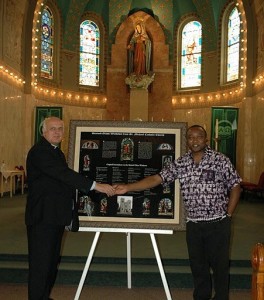
Msgr. Frank Kurzaj, president of the FLM Foundation, and Rev. Paschal Amagba, pastor of Immaculate Heart of Mary Church. [photographer- Elaine Mazurek Stephens]
The original St. Michael Catholic Church was the center of the third oldest parish in San Antonio, Texas, and a nucleus for the Polish people of the city. It began with the arrival of Father Vincent Barzynski of the Resurectionist Order who was the earliest resident pastor. On November 18, 1866, the first Mass of the newly organized parish was celebrated in the San Fernando Cathedral. Then divine services were held in a one-story, rock building owned by Emanuel Rzeppa, a baker and charter member of the parish, while the first church was constructed in 1868. The original church was torn down and a larger edifice of white brick was erected in 1922. The treasured stained glass windows from the 1922 church are the focus of the framed memoir prepared by the Silesian Texan website committee including Msgr. Kurzaj, Janet Dawson Ebrom, and Elaine Mazurek Stephens who had also photographed the windows with James Collins.
The history of St. Michael’s is deeply personal to those who were in attendance for the informal presentation: Lynn Highley, descendant of Emanuel Rzeppa whose building remains in HemisFair Plaza; Barbara Stanush, whose late husband Claude Stanush, a prolific author and San Antonio treasure, grew up in St. Michael Parish; Michele Stanush, Carol Stanush Gagliardi, and Ashley Stanush Jackson whose ancestors, Ignatz and Mary Burda, had been memorialized with a stained glass window of St. Ignatius; Dorothy Pollok Pawelek whose relatives, the Frank Pollok family, had been paid tribute with a stained glass window of the Holy Family. Other families whose ancestors were members of historic St. Michael’s may visit Immaculate Heart of Mary Church to set eyes on the jewel-toned windows which reflect the faith of their forebears.
Presentation of second gift
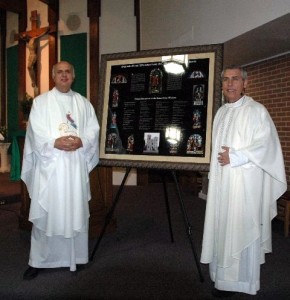
Msgr. Frank Kurzaj and Rev. Heliodoro Lucatero, pastor of St. Michael Catholic Church. [photographer-Elaine Mazurek Stephens]
Some of the current parishioners shared their childhood memories of the historic St. Michael’s which had been built in 1922. Arthur Martinez reminisced about making his First Holy Communion in the venerable church which had been on South Street and discussed the transfer of the marble communion rail to Immaculate Heart of Mary Church along with the windows over forty years ago. Josephine Garcia shared fond memories of attending St. Michael Academy and graduating from high school there in 1950 when it was still thriving. She recalled the surnames of some families of Polish descent who had been her classmates and neighbors: Morgozewitz, Pruski, and Winkler.
Preserving St. Michael’s storied past is one of the important objectives of the Silesian Texan website committee related to this project. The artistic displays including the names of departed parishioners who had windows dedicated in their memory will not only raise public awareness but will also honor some of the early Polish immigrant families of San Antonio.
![St. Michael stained glass window originally donated by Theo and Pauline Magott. The windows are now at Immaculate Heart of Mary Church in San Antonio, Texas. [photographer – Elaine Mazurek Stephens]](https://silesiantexans.com/wp-content/uploads/cache/2015/05/0041/3559114180.jpg)
![Left to right: Elaine Mazurek Stephens, Michele Stanush, Ashley Stanush Jackson, Barbara Stanush, Carol Stanush Gagliardi, Dorothy Pawelek, Msgr. Frank Kurzaj, Lynn Highley, Dorothy Collins, and Janet Dawson Ebrom at the Immaculate Heart of Mary Church presentation. [photographer - James Collins]](https://silesiantexans.com/wp-content/uploads/cache/2015/05/0051/3084737817.jpg)
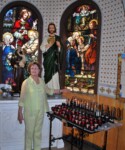
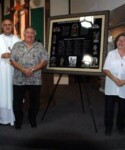
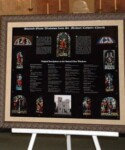

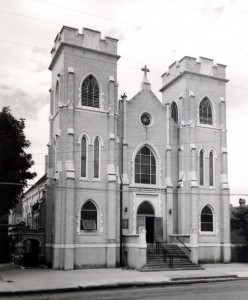
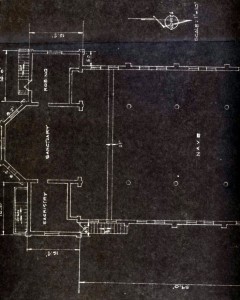
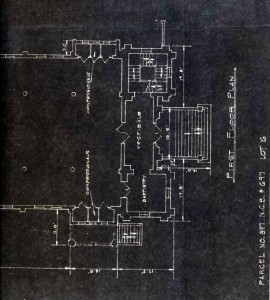
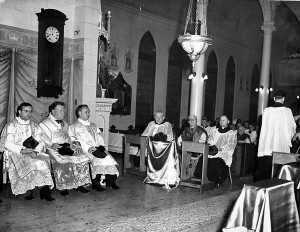
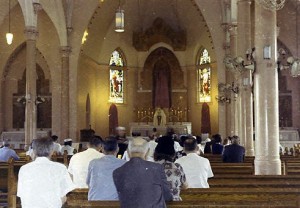





















![St. Michael Catholic Church built in 1922 [photo courtesy of St. Michael’s parish archives].](https://silesiantexans.com/wp-content/uploads/cache/2015/05/003/657476104.jpg)

![Msgr. Frank Kurzaj and Rev. Heliodoro Lucatero with the youngest generation of St. Michael’s parishioners [photographer – Elaine Mazurek Stephens]](https://silesiantexans.com/wp-content/uploads/cache/2015/05/0101/1126269492.jpg)